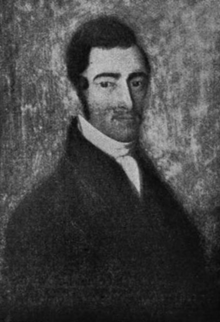Jonathan P. Cushing
Jonathan Peter Cushing (March 12, 1793 – April 25, 1835) was the fifth president of Hampden–Sydney College.
Jonathan Peter Cushing | |
|---|---|
 | |
| 5th President of Hampden–Sydney College | |
| In office September 1821 – 1835 | |
| Preceded by | Moses Hoge |
| Succeeded by | George A. Baxter (Acting) |
| Personal details | |
| Born | March 12, 1793 Rochester, New Hampshire |
| Died | April 25, 1835 (aged 42) Raleigh, North Carolina |
| Alma mater | B.A. Dartmouth College |
| Profession | Theologian |
Biography
Jonathan Cushing born to Peter and Hannah Cushing in Rochester, New Hampshire, in 1783. He graduated from Dartmouth College in 1817, and soon after traveled south. While in Richmond he agreed to temporarily take the place of a sick tutor at Hampden–Sydney College. He was soon made a professor, and when President Dr. Moses Hoge died in 1820 Cushing succeeded him in the presidency. With his accession ended the formative period of the institution, which now began its rapid growth into the proper functions and domain of a college. Cushing secured an endowment and built the present college edifice and the president's residence.
Cushing became vice president of the Virginia Historical and Philosophical Society at its incorporation, with Chief Justice John Marshall as president. Dr. Cushing's health was shattered by an accidental discharge from an electric battery while he was experimenting before his class. He died April 25, 1835, in Raleigh, North Carolina. [1]
Cushing Hall (originally known as New College) at Hampden–Sydney was built during his tenure and was subsequently named in his honor. It is the oldest four-story dormitory still in use in the United States.[2]
President Cushing graduated an unusually large number of famous men: William Ballard Preston (Secretary of the Navy under President Zachary Taylor), Dr. Thomas Atkinson (Episcopal Bishop of the Diocese of North Carolina), Hugh A. Garland (U.S. Congressman and Clerk of the U.S. House of Representatives), William A. Daniel (Justice of the Virginia Supreme Court), Congressman William M. Tredway, Landon C. Garland (President of Randolph–Macon College and Chancellor of Vanderbilt University), Jesse Burton Harrison, who was a vocal opponent of slavery as well as a historian, who died too early to have produced the work that his talent suggested he would produce, Maryland Governor Thomas W. Ligon, Dr. John Lycan Kirkpatrick (President of Davidson College), and Dr. John M. P. Atkinson (President of Hampden–Sydney College]].[3] During Cushing's presidency the Hampden-Sydney literary societies were established and prospered.[4]
References
- Tyler, Lyon Gardiner (1915). Encyclopedia of Virginia Biography: Volume II. New York: Lewis Historical Publishing Company.
- Brinkley, John Luster (1994). On This Hill: A narrative history of Hampden–Sydney College, 1774–1994. Hampden–Sydney, VA: Hampden–Sydney College. ISBN 1-886356-06-8.
- "Lacy, Drury". The National Cyclopædia of American Biography. II. New York: James T. White & Company. 1921. p. 22.
- Some of the more important literary addresses from Cushing's presidency were published as Six Addresses on the State of Letters and Science in Virginia ...1824-35 (Roanoke, 1917).
| Academic offices | ||
|---|---|---|
| Preceded by Moses Hoge |
President of Hampden–Sydney College 1821 - 1835 |
Succeeded by George A. Baxter |